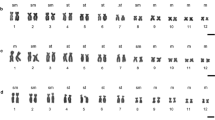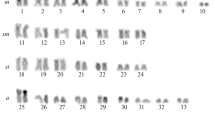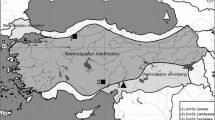Abstract
Graomys griseoflavus is a South American phyllotine rodent having a remarkable Robertsonian polymorphism which may have produced reproductive isolation between 2n=42−41 and 2n=38−34 karyomorphs. Analysis of nucleolar organizer region (NOR) locations both by silver staining (Ag-NOR) and in situ hybridization revealed that 2n=42 individuals exhibit highly variable Ag-NOR patterns, while specimens of the 2n=38−34 karyomorphic group showed a single Ag-NOR pattern. The latter animals underwent two NOR deletions in reference to the 2n=42 karyomorphs, one of which would be the consequence of a Robertsonian fusion and the other would be produced by the unequal crossing-over mechanism. The differential NOR homogenization supports the hypothesis that G. griseoflavus karyomorphs are evolving separately towards the acquisition of separate species status.
Similar content being viewed by others
References
Arnheim, N., M. Kristal, R. Schmickel, G. Wilson, O. Ryder & E. Zimmer, 1980. Molecular evidence for genetic exchanges among ribosomal genes on nonhomologous chromosomes in man and apes. Proc. Natl. Acad. Sci. USA 77(12): 7323–7327.
Arnheim, N., 1983. Concerted evolution of multigene families. In: Evolution of genes and proteins. M. Nei and R.K. Koehn (eds) Sinauer, Sunderland, pp. 38–61.
Erickson, J.J., C.L. Rushford, D.J. Dorney, G.N. Wilson & R.D. Schmickel, 1981. Structure and variation on human ribosomal DNA: molecular analysis of cloned fragments. Gene 16: 1–9.
Howell, W.M. & D.A. Black, 1980. Controlled silver staining of nucleolus organizer regions with protective colloidal developer: a one step method. Experientia 36: 1014–1015.
Martínez, P., A. Viñas, C. Bouza, J. Castro & L. Sańchez, 1993. Quantitative analysis of the variability of nucleolar organizer regions in Salmo trutta. Genome 36: 1119–1123.
Ohta, T., 1980. Evolution and variation of multigene families. Springer-Verlag, Berlin.
Pardue, M.L., 1985. In situ hybridization. In: Nucleic acid hybridization. B.D. Hames and S.J. Higgins (eds) IRL Press, Oxford, pp. 179–202.
Pendás, A.M., P. Morán & E. García-Vázquez, 1993. Ribosomal RNA genes are interspersed throughout a heterochromatic arm in Atlantic salmon. Cytogenet. Cell Genet. 63: 128–130.
Phillips, R.B., K.A. Pleyte, L.M.Van Ert & S.E. Hartley, 1989. Evolution of nucleolar organizer regions and ribosomal RNA genes in Salvelinus. Physiol. Ecol. Jpn. 1: 429–447.
Sánchez, A., M. Burgos, R. Jiménez & Díaz de la Guardia, 1990. Variable conservation of nucleolus organizer regions during karyotypic evolution in Microtidae. Genome 33: 119–122.
Seperack, P., M. Slatkin & N. Arnheim, 1988. Linkage disequilibrium in human ribosomal genes: implications for multigene family evolution. Genetics 119: 943–949.
Schubert, I. & U. Wobus, 1985. In situ hybridization confirms jumping nucleolus organizing regions in Allium. Chromosoma 92: 143–148.
Smith, G.P., 1976. Evolution of repeated DNA sequences by unequal crossover. Science 191: 528–535.
Suzuki, H., Y. Kurihara, T. Kanehisa & K. Moriwaki, 1990. Variation in the distribution of silver-staining nucleolar organizer regions on the chromosomes of the wild mouse, Mus musculus. Mol. Biol. Evol. 7(3): 271–282.
Vaughan, H.E., M. Jamilena, C. Ruíz Rejón, J.S. Parker & M.A. Garrido-Ramos, 1993. Loss of nucleolar-organizer regions during polyploid evolution in Scilla autumnalis. Heredity 71: 574–580.
Vidal-Rioja, L., M.L. Larramendy & L. Semorile, 1989. Ag-NOR staining and in situ hybridization of rDNA in the chromosomes of the South American camelids. Genetica 79: 215–222.
Zambelli, A., F. Dysenchauz, A. Ramos, N.De Rosa, R. Wainberg & O.A. Reig, 1992. Cytogenetics and karyosystematics of phyllotine rodents (Cricetidae, Sigmodontinae). III. New data on the distribution and variability of karyomorphs of the genus Eligmodontia. Z. Säugetierkd. 57: 155–162.
Zambelli, A., L. Vidal-Rioja & R. Wainberg, 1994. Cytogenetic analysis of autosomal polymorphism in Graomys griseoflavus (Rodentia, Cricetidae). Z. Säugetierkd. 59: 14–20.
Zambelli, A. & L. Vidal-Rioja, 1995. Molecular analysis of chromosomal polymorphism in the South American cricetid, Graomys griseoflavus. Chrom. Res. 3: 361–367.
Author information
Authors and Affiliations
Rights and permissions
About this article
Cite this article
Zambelli, A., Vidal-Rioja, L. Loss of nucleolar organizer regions during chromosomal evolution in the South American cricetid Graomys griseoflavus . Genetica 98, 53–57 (1996). https://doi.org/10.1007/BF00120218
Received:
Accepted:
Issue Date:
DOI: https://doi.org/10.1007/BF00120218




